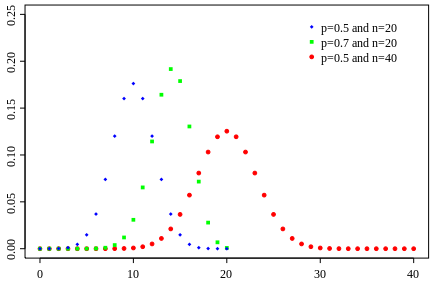Here’s a bet. I flip a coin a total number  of times and you win £1000 if it comes up heads
of times and you win £1000 if it comes up heads  times, otherwise you lose £1000. What’s the probability of you winning for different values of
times, otherwise you lose £1000. What’s the probability of you winning for different values of  and
and  ?
?

The binomial distribution for different pairs of values of n and k. The graph plots the probability that k out of n trials are a success against the value of k.
The answer is given by the binomial distribution. Phrased in more general terms, the distribution gives the probability of achieving  successes (eg getting heads) in a total number of
successes (eg getting heads) in a total number of  trials of a process (eg flipping a coin).
trials of a process (eg flipping a coin).
To work out the distribution we need to know the probability of a success. In our coin example, this would be  for a fair coin, but could be another value for a crooked coin. To capture the general case let’s just write
for a fair coin, but could be another value for a crooked coin. To capture the general case let’s just write  for that probability.
for that probability.
The probability of observing a particular sequence of successes and failures in a particular order is equal to the product of the individual probabilities. For example, the probability of observing the sequence Success, Success, Failure is
![\[ p \times p \times (1-p). \]](/MI/01cb1d8becce37e7e5d06070d48de80c/images/img-0001.png) |
But we don't mind what order our successes and failures come in, we just care about the total number of successes. That means we need to add up the probabilities of each sequence that results in the right number of successes. Going back to the example of three trials and two successes, we could have
- Success, Success, Failure
- Success, Failure, Success
- Failure, Success, Success.
Each of these has a probability  so the probability of one of the three possible outcomes occurring is
so the probability of one of the three possible outcomes occurring is
![\[ 3\times p \times p \times (1-p)=3p^2(1-p). \]](/MI/79a6d6e1fcde782fd187e1acb496c362/images/img-0002.png) |
Writing this more generally,
![\[ P\left(\mbox{$k$ successes from $n$ trials}\right) = {{n}\choose {k}} p^ k (1-p)^{n-k}. \]](/MI/79a6d6e1fcde782fd187e1acb496c362/images/img-0003.png) |
Here the variable  can take values
can take values  ,
,  ,
,  , up to
, up to  , and the first term is the binomial coefficient
, and the first term is the binomial coefficient
![\[ {{n}\choose {k}} = \frac{n!}{(n-k)!k!}. \]](/MI/79a6d6e1fcde782fd187e1acb496c362/images/img-0009.png) |
The exclamation mark denotes the factorial which is defined as
![\[ n! = n \times (n-1) \times (n-2) ... \times 2 \times 1. \]](/MI/79a6d6e1fcde782fd187e1acb496c362/images/img-0010.png) |
The binomial coefficient can be thought of as the number of ways of choosing an unordered list of  outcomes from
outcomes from  possibilities. You can find out more here.
possibilities. You can find out more here.
 and variance
and variance  . To see a worked example of the binomial distribution in action, read this article.
. To see a worked example of the binomial distribution in action, read this article.